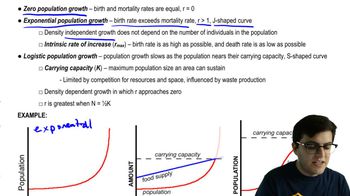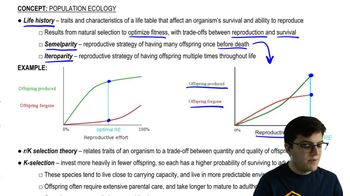Table of contents
- 1. Introduction to Biology2h 40m
- 2. Chemistry3h 40m
- 3. Water1h 26m
- 4. Biomolecules2h 23m
- 5. Cell Components2h 26m
- 6. The Membrane2h 31m
- 7. Energy and Metabolism2h 0m
- 8. Respiration2h 40m
- 9. Photosynthesis2h 49m
- 10. Cell Signaling59m
- 11. Cell Division2h 47m
- 12. Meiosis2h 0m
- 13. Mendelian Genetics4h 41m
- Introduction to Mendel's Experiments7m
- Genotype vs. Phenotype17m
- Punnett Squares13m
- Mendel's Experiments26m
- Mendel's Laws18m
- Monohybrid Crosses16m
- Test Crosses14m
- Dihybrid Crosses20m
- Punnett Square Probability26m
- Incomplete Dominance vs. Codominance20m
- Epistasis7m
- Non-Mendelian Genetics12m
- Pedigrees6m
- Autosomal Inheritance21m
- Sex-Linked Inheritance43m
- X-Inactivation9m
- 14. DNA Synthesis2h 27m
- 15. Gene Expression3h 20m
- 16. Regulation of Expression3h 31m
- Introduction to Regulation of Gene Expression13m
- Prokaryotic Gene Regulation via Operons27m
- The Lac Operon21m
- Glucose's Impact on Lac Operon25m
- The Trp Operon20m
- Review of the Lac Operon & Trp Operon11m
- Introduction to Eukaryotic Gene Regulation9m
- Eukaryotic Chromatin Modifications16m
- Eukaryotic Transcriptional Control22m
- Eukaryotic Post-Transcriptional Regulation28m
- Eukaryotic Post-Translational Regulation13m
- 17. Viruses37m
- 18. Biotechnology2h 58m
- 19. Genomics17m
- 20. Development1h 5m
- 21. Evolution3h 1m
- 22. Evolution of Populations3h 52m
- 23. Speciation1h 37m
- 24. History of Life on Earth2h 6m
- 25. Phylogeny2h 31m
- 26. Prokaryotes4h 59m
- 27. Protists1h 12m
- 28. Plants1h 22m
- 29. Fungi36m
- 30. Overview of Animals34m
- 31. Invertebrates1h 2m
- 32. Vertebrates50m
- 33. Plant Anatomy1h 3m
- 34. Vascular Plant Transport2m
- 35. Soil37m
- 36. Plant Reproduction47m
- 37. Plant Sensation and Response1h 9m
- 38. Animal Form and Function1h 19m
- 39. Digestive System10m
- 40. Circulatory System1h 57m
- 41. Immune System1h 12m
- 42. Osmoregulation and Excretion50m
- 43. Endocrine System4m
- 44. Animal Reproduction2m
- 45. Nervous System55m
- 46. Sensory Systems46m
- 47. Muscle Systems23m
- 48. Ecology3h 11m
- Introduction to Ecology20m
- Biogeography14m
- Earth's Climate Patterns50m
- Introduction to Terrestrial Biomes10m
- Terrestrial Biomes: Near Equator13m
- Terrestrial Biomes: Temperate Regions10m
- Terrestrial Biomes: Northern Regions15m
- Introduction to Aquatic Biomes27m
- Freshwater Aquatic Biomes14m
- Marine Aquatic Biomes13m
- 49. Animal Behavior28m
- 50. Population Ecology3h 41m
- Introduction to Population Ecology28m
- Population Sampling Methods23m
- Life History12m
- Population Demography17m
- Factors Limiting Population Growth14m
- Introduction to Population Growth Models22m
- Linear Population Growth6m
- Exponential Population Growth29m
- Logistic Population Growth32m
- r/K Selection10m
- The Human Population22m
- 51. Community Ecology2h 46m
- Introduction to Community Ecology2m
- Introduction to Community Interactions9m
- Community Interactions: Competition (-/-)38m
- Community Interactions: Exploitation (+/-)23m
- Community Interactions: Mutualism (+/+) & Commensalism (+/0)9m
- Community Structure35m
- Community Dynamics26m
- Geographic Impact on Communities21m
- 52. Ecosystems2h 36m
- 53. Conservation Biology24m
50. Population Ecology
Introduction to Population Ecology
Problem 4d
Textbook Question
Textbook QuestionWhy is there a trade-off between survivorship and fecundity?
 Verified step by step guidance
Verified step by step guidance1
Understand the concept of life history strategies: Life history strategies are the ways in which organisms allocate resources to growth, reproduction, and survival. These strategies are shaped by evolutionary pressures to maximize fitness in a given environment.
Define survivorship and fecundity: Survivorship refers to the ability of an organism to live through various stages of its life cycle, while fecundity refers to the reproductive capacity of an organism, i.e., the number of offspring it can produce.
Recognize the resource allocation constraint: Organisms have limited resources (such as energy and nutrients) to allocate towards growth, reproduction, and maintenance (including survival). Allocating more resources to one function means fewer resources are available for others.
Examine the trade-off mechanism: If an organism allocates more resources to survivorship (e.g., better immune function, stronger bodily structures), it may have to reduce the resources allocated to fecundity, resulting in fewer offspring. Conversely, if more resources are directed towards producing more offspring, the organism might reduce investment in its own survival mechanisms.
Explore examples and ecological implications: In different environments, the balance of this trade-off can affect the population dynamics and evolutionary outcomes. For example, in stable environments, species might evolve to prioritize survivorship, while in unpredictable environments, high fecundity might be favored to ensure at least some offspring survive.
Recommended similar problem, with video answer:
 Verified Solution
Verified SolutionThis video solution was recommended by our tutors as helpful for the problem above
Video duration:
3mPlay a video:
Was this helpful?
Key Concepts
Here are the essential concepts you must grasp in order to answer the question correctly.
Survivorship
Survivorship refers to the probability of an individual organism surviving to a particular age. It is a key component of life history strategies, which describe how organisms allocate resources to growth, reproduction, and survival. High survivorship often indicates that an organism has traits that enhance its longevity, such as effective predator avoidance or efficient resource use.
Recommended video:
Guided course

Survivorship
Fecundity
Fecundity is the reproductive capacity of an organism, typically measured by the number of offspring produced in a given time period. It reflects an organism's ability to reproduce and is influenced by factors such as age, health, and environmental conditions. High fecundity can lead to increased population growth but may also require significant energy investment, impacting survival.
Recommended video:
Guided course

Life History
Life History Trade-offs
Life history trade-offs are the compromises that organisms make between different biological functions, such as growth, reproduction, and survival. For example, investing more energy in reproduction (high fecundity) may reduce the energy available for survival, leading to lower survivorship. Understanding these trade-offs helps explain the diversity of reproductive strategies observed in nature.
Recommended video:
Guided course

Life History

 1:17m
1:17mWatch next
Master Population Ecology with a bite sized video explanation from Jason Amores Sumpter
Start learningRelated Videos
Related Practice


































































